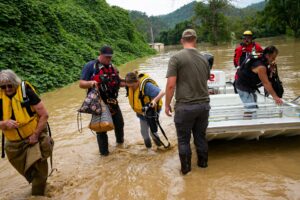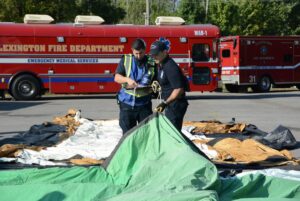Since its inception, the primary goal of the Chemical Stockpile Emergency Preparedness Program (CSEPP) is to educate and enhance emergency preparedness in communities surrounding the chemical stockpile stored at the Bluegrass Army Depot. As operations wind down at the site, local emergency managers and first responders in Clark, Estill, Fayette, Garrard, Jackson, Laurel, Madison, Rockcastle, and Powell counties used their CSEPP training to benefit communities by deploying to help Kentuckians recover after recent natural disasters.
On July 27, 2022, multiple thunderstorms impacted Eastern Kentucky, resulting in catastrophic flooding and mudslides. On July 29th, President Biden issued a major declaration for the Commonwealth. This was a 1000-year disaster which many hope never to live thru again.

Clark County deployed a five-person team of Swift Water Rescue Technicians and their new boat.
Clark County deployed a five-person team of Swift Water Rescue Technicians and their new boat, as part of a regional task force, to respond to trapped residents in Breathitt County. These crews assisted in the evacuation and rescue of approximately 100 individuals. CSEPP officials supported the regional Incident Management Team (IMT), functioning as an operations deputy for five days at the area command integration with the Federal Emergency Management Agency (FEMA) team and other commonwealth personnel. As the water receded, three rescue technicians deployed to aid with search and rescue operations, damage and hazard assessments, lifeline support, and Quick Response Operations for immediate hazards in Breathitt and Letcher counties, completing 358 damage assessments and human interactions.
Estill County deployed personnel as part of the Bluegrass Emergency Response Team Incident Management Team (BERT IMT). The IMT was deployed to the National Guard Armory in Hazard, KY, relieving the Northern KY IMT and the FEMA USAR task force. A county official served as Planning Section Chief for the first 5 days and as a Liaison Officer (assigned to Breathitt & Wolfe counties), as the mission changed from response to short-term recovery. The training provided by CSEPP was beneficial: specifically, the courses on disaster mitigation, recovery, public information/warning, donations management, volunteer management, communications, emergency planning, ICS 300/400, ICS position specific courses (PSC, OSC, LSC, etc.), 0305 – IMT course, and critical infrastructure courses. Previous experience working with other county EMs, KYEM, and FEMA proved beneficial during the response, encountering EMs and Radiological Emergency Preparedness (REP) with FEMA Region IV that had previously evaluated Estill County in CSEPP.

Fayette County deployed the Mobile Ambulance Bus (MAB).
Fayette County deployed the Mobile Ambulance Bus (MAB) to eastern Kentucky for the flood response. The Lexington-Fayette Urban County Government CSEPP Public Information Officer supported the flooding response as part of the Joint Information System (JIS). He worked in person at the Joint Information Center at the Kentucky Emergency Management (KYEM) Emergency Operations Center (EOC) as well as providing remote support in briefing the media and keep the public aware of the emergency response.

Members from the Garrard County Sheriff’s Department, Judge Executive, and County Clerk traveled to Eastern Kentucky to be of assistance to anyone in need.
Garrard County EMA/CSEPP encouraged and provided donations including- cash donations, bottled water, cleaning supplies, and hygiene products in response to the Eastern Kentucky flooding event. Garrard County collected donations county-wide and the local road department transported them to Eastern Kentucky. Members from the Garrard County Sheriff’s Department, Judge Executive, and County Clerk traveled to Eastern Kentucky to be of assistance to anyone in need.
Jackson County EMA/CSEPP Director deployed as part of the Northern Kentucky All-Hazards IMT and supported organizing transport resources for the commonwealth in Knott County. This team, along with a Cumberland Valley MSAR member moved drinking water from the Appalachian Wireless Arena to area fire departments for distribution to the public after the disaster. They also provided the town of Neon with an 18′ enclosed trailer for alternate storage.
Jessamine County and Nicholasville Fire department deployed resources to Jackson and Breathitt County for the initial response as part of Bluegrass Emergency Response Team (BERT) doing Ground and Water Search, Rescue and Recovery. Crews worked hard hit areas by boat and utility task vehicle (UTV) that were inaccessible by vehicle. Personnel supported and maintained contact with the National Guard’s medivac division, the Kentucky Helicopter Aquatic Rescue Team (KHART) as they are called, were searching for victims in flooded structures. Jessamine County crews also deployed to Knott County and worked in the Hindman area and other rural areas conducting door to door surveys and damage assessments. The Jessamine EMS mass casualty transport unit deployed to aid evacuation from flood threatened nursing facilities in Pike and Jackson Counties. Ground support EMS staff also deployed in those areas.
Laurel County CSEPP received resource requests through KYEM to deliver, program, and place four PP Message Boards at various locations in Letcher County. These message boards were maintained from July until September to inform survivors and volunteers about shelter locations, donation delivery locations, food serving locations, and hours of the FEMA Disaster Registration Centers. Laurel County used prime movers to move the message boards from one location to another, and updated messages, as needed.
Other assets deployed included three 25-person sheltering carts hauled by a CSEPP truck and 20’ Trailer. Two of these carts were deployed to Letcher County at the American Legion Post for Team Rubicon. The third was sent to Pike County for Clark County Road Department responders to sleep in. Each sheltering cart includes the following: oversized cots, polar fleece blankets, inflatable cot pillows, first aid kits, emergency weather alert radio, hygiene tubes, lanterns, and d size batteries.
The Laurel County CSEPP animal sheltering trailer was used at the Red Cross shelter in Whitesburg. The Animal Sheltering trailer is set up with approximately 38 stainless steel cages with aluminum doors, expandable to 43 with removable dividers, a fresh water 20-gallon tank, waste water 25 gallon holding tank with Recreational Vehicle (RV) style dump, on board generator, stainless steel sink area with interior and exterior lighting and 3 solid awnings on curb side of trailer and 2 solid awnings on road side in which raise and lock in position to allow easy viewing of pets through a Plexiglas wall. This is a self-supporting trailer, with an electrical hook up just like a RV or on-board generator when electricity is not available.
Many Laurel County citizens and the county Fiscal Court collected donations for flood survivors, and specifically collected donations of school supplies for the city of Fleming-Neon in Letcher County. Numerous first responders (fire fighters, law enforcement, search and rescue personnel) deployed, as well as local citizens who volunteered with their churches or other organizations.
Madison County sent three staff as part of the Central Kentucky Incident Management Team (IMT) to serve in area command. A transport bus with one Emergency Management Agency (EMA) and one Emergency Medical Services (EMS) staff member assisting was deployed twice to help move nursing home patients between counties.
Powell County provided direct support to Wolfe County and Breathitt County. During the first 48 hours one swift water team responded to Breathitt County, which included a 15-member search and rescue (SAR) team. Simultaneously, one EMS unit and a sheltering trailer were deployed to Wolfe County to assist with sheltering operations. Sheltering was provided for survivors and their animals, in Wolfe County. SAR operations were mainly focused in Breathitt County but assistance was provided as requested. Powell County SAR used teams which included local volunteer Fire Departments (FD), typically 10-firemen, daily the first week.
Powell County EMS equipment funded through the CSEPP program, Striker cots, Lucas devices, medical jump bags, etc., were used to assist with the evacuation and sheltering operation of a Breathitt County nursing home, short term sheltering at Wolfe County Schools, and helped increase safety of our SAR/FD personnel in the affected areas. CSEPP radios were programed with Breathitt County frequencies which greatly enhanced their range and provided much needed coordination with the affected county.
Rockcastle County CSEPP supported the response to the floods in Eastern Kentucky, partnering with the local school system to provide two enclosed trailers to be used for transporting local donations to the impacted area. One trailer was used for a second trip, the local fire departments used it to collect and transport donations to Eastern Kentucky.
As we enter tornado season, talk to your family about being prepared. Have a family emergency plan and build a family emergency kit. Make sure every member of your family is informed and prepared for an emergency situation. Visit https://prepareky.com/ to learn more.
Guest Contributor: Linda L. Gunter, Creative Services Specialist, Office of External Affairs, Federal Emergency Management Agency FEMA.gov